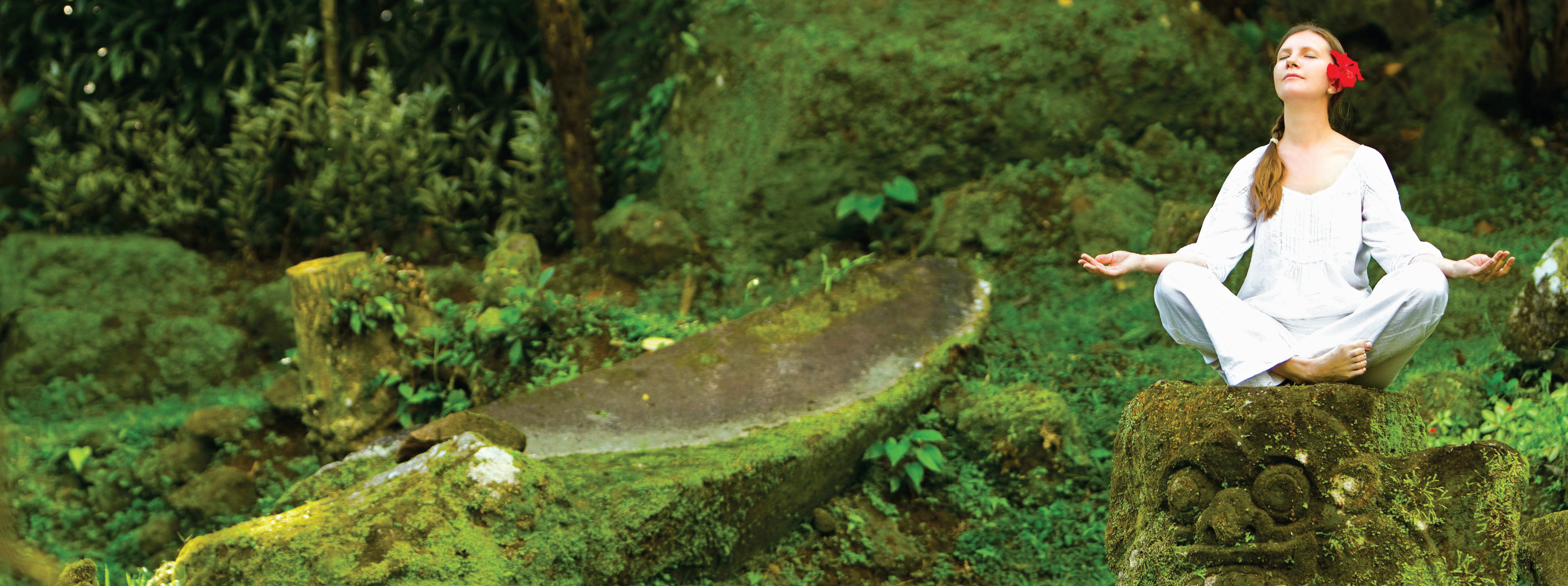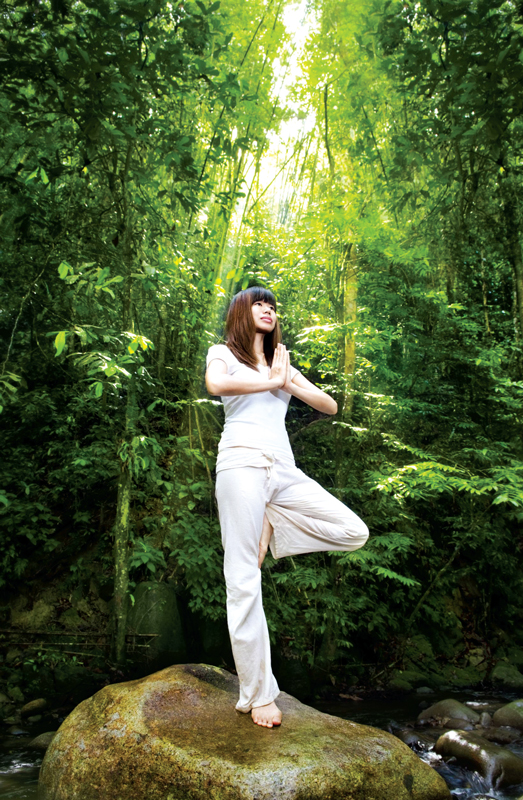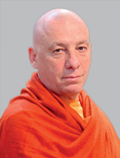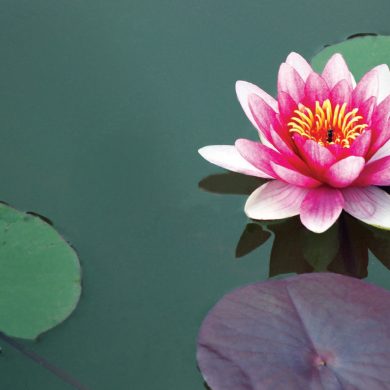Learning to live in the stillness of the heart is central to spiritual growth. An authentic spiritual practice provides us with the tools to contact this deepest resonance of our heart—both during our meditation and as we extend ourselves out into the world. We anchor ourselves in our center, in the stillness of our heart, and this is what creates a profound, permanent immersion into the heart of God.
Stillness is the doorway into God’s heart, and we find this entryway through our own consciousness when we experience:
The stillness of breath
The stillness of desire
The stillness of awareness
The stillness of will.
Divine Presence is within each of us, always available in every moment to anyone who wishes to connect to it. It is not just the purview of extraordinary saints. They are simply a beacon, shining a light on what is accessible to everyone. We all have the Divine right to live in that state. The immersion into what my root guru Bhagavan Nityananda called the “heart-space” or “sky of the heart” is at once a technical process—the development of the capacity to focus our awareness into the deepest still point within us—and also the expression of understanding that comes from making contact with stillness. Presence is revealed from within each of us if we can bring stillness to every dimension of our lives.
Stillness of breath
As we become very still inside we are able to feel the vibrating radiance of consciousness from which all levels of breath arise and unfold. We experience the internal breath, which is the very power of life, arising and subsiding within us. This breath of life creates our body and our physical breath from within itself. What appears to be the body and gross breath is really an effect of this pulsation of vitality, which is ever-flowing in the sushumna. In stillness, we can notice each internal breath lifting our vital force from the base of the spine, up through the sushumna, and into the center of the head, without ever taking a physical breath.
When we tune in to the internal breath we are not breathing in and out. The breath is entirely within the sushumna, and this is why the experience is ultimately not one of breathing, but of being breathed. There is an incredible line in one of the Nityananda Sutras that says, “Those who do not breathe through the nostrils have no desire. When, with practice, the breath is controlled, it becomes centered in the sushumna. The breath is purely internal, and joy and bliss flow within. When the sadhak draws up the internal breath to the heart-space he realizes himself as the Self.”
Established in stillness of breath, our awareness is still, our desires are still, and our will is still. Desire is for something other, outside of us. Even the desire for an external breath is a reflection of our limited perception that breathing in and out is what gives us life. When we recognize that we are being breathed by God we are fulfilled and have no sense of lack, and therefore no desires. We realize we are alive because of the Grace of God.
Even the internal breath is the effect of consciousness. It arises from a still point, begins to vibrate, and becomes the form of our gross breath. Discriminating awareness is necessary to find the still point of consciousness— and then we must surrender into that Presence in order to feel the internal breath arising. This is what creates a permanent internal awareness, which is the basis of changing our experience of life.
The stillness of awareness
We must make the choice to move beyond our patterns and tensions. We cannot allow them to dictate our experience. If we either get caught in emotional turmoil or try to numb our pain (through whatever means), we are denying ourselves the opportunity to be free. My teacher Rudi always said, “Pain is God loving you.” He meant that all the experiences in our lives are divinely offered as the means to freedom —not just the blissful ones. The most intense difficulties contain the biggest opportunity for liberation. When we are able to abide in stillness, we can simply witness the merry-ground of our tensions, patterns, and struggles, and recognize that they are our attempt to remain bound.
Stillness of awareness is a critical capacity that any authentic spiritual aspirant must develop. We learn to rest in our center, watch, and say, “I see and understand what is happening. I don’t have to engage this dynamic in order to free myself from it.” In fact, this is the fastest way out of any misunderstanding, because when we are not caught in the drama, we avoid being overwhelmed over and over again by the same energy. When the whirlwind we face is almost more intense than we can bear, it is a reflection of how tightly we are holding on to not being free.

Profound transformation happens because we change inside. We can change our behavior—and that can give us some clue as to what our life should look like. But we have to be careful when doing this because we are projecting what our behavior and experience should be, based only on our imagination about something we have yet to experience. We are projecting based on our limited awareness. Still, we do need the discipline to work and make conscious choices even when we have not yet found a higher level of inner consciousness. We develop a willingness to function from a deeper place even if we don’t fully understand it. The time to do this is whenever our life is asking it of us.
The stillness of desire
When we live in a state of desirelessness, we recognize that there is no “other” needed for our fulfillment. In a state of non-attachment, we realize our desires are superficial. They are only of the mind. This does not mean that if we are desireless we don’t have anything, because in reality, when we truly desire nothing we have everything. Living in this state, there is never a question about wanting or not wanting something—only the reality of not needing it. We simply do not need anything in order to be free and complete.
It is only our attachment to things that binds and limits us. So often, we experience “I have this, it makes me happy. I don’t have that, I feel unhappy.” It’s fine to be happy about having something, but the problem is that we are miserable without it. This pattern reinforces the belief that we cannot be happy without something other, and so we try to control life in order to get what we think will make us whole. When we believe there is something external that determines our experience, we start to blame something or somebody else for our unhappiness. We don’t take responsibility for how we feel, and so we lose the power to change our experience. In this circular pattern, we thereby prove that “something” caused our misery.
If we buy into the idea that someone or something else can make us unhappy, we have just proved it to be true. We then continually reach outside ourselves to find whatever we think will fill the empty place in our own hearts. We feel this emptiness because of our perceived separation from God, but that perception is only a trick of the ego. If all of life is a manifestation of Pure Consciousness, how can we be separate from anything? When we are free from the misunderstanding that there is something missing in our life, we are also free from needing anything.
Freeing ourselves from attachment
There is a profound difference between the need or desire for something, and simply celebrating having it. When we have what we want, and we could be enjoying its existence in our life, what do we usually do instead? We strangle it to death in our attempt to hold on to it. Fear of loss begins to surface, and that makes us contract. We are no longer concerned about what we were originally attached to, but simply unhappy about what might happen if we lose it. An incredible fear locks us down, and so a vicious loop reinforces itself. The desires of the ego perpetuate the ego, and all of our pain and attachments are symptoms of that ongoing drama.

Freeing ourselves from attachments necessitates that we make some conscious choices. It may require the discipline to let go of what is binding us; to let go of some “thing” we feel we must have or we are going to die. But what happens when we surrender the very thing we can’t let go of? We experience spaciousness and freedom. We feel stronger. Perhaps we should write notes to ourselves and post them everywhere, so that the next time something starts to grip us, we have a reminder of what is happening—which is that we’re being given the opportunity to find freedom.
The loss of whatever we hold on to can actually be God’s way of bestowing Grace and freedom on us. But the receiving of this gift is not always easy, and our stillness of desire will be tested. Circumstances that provide opportunities for us to grow and change will continually be put in front of us. The mind has an incredible power to convince us of its own perspective. Because we are so attached to our desires, it requires a great deal of strength, courage, discipline and clarity to gain our freedom.
It is vital to recognize that desire and attachment come from the mind—and that the mind is able to create an extraordinary amount of delusion in us. When we find ourselves caught in turmoil, it is a strong clue that we need to get still. Instead of immediately reacting to the incessant need to do something, find something, or get rid of something, we rest in stillness. If we do that, whatever we are attached to will lose its grip. Desirelessness is freedom from the incessant thought and feeling that life has to be a certain way. It is the recognition of the perfection of our life at every moment. In this acceptance, what can we desire, except to allow Grace to unfold? This is not a concept. It is not theory. It should be and can be our experience that perfection is unfolding in our life at every moment. When we still our desires and awareness we cut the cords of attachment, which frees us to be immersed in our highest Self. We discover unconditional joy within ourselves not by manipulating, pushing, and shoving, not by trying to make life different, but by simply diving into the state of consciousness where perfection is crystal clear.
The stillness of will
Ultimately, desirelessness shows itself as stillness of will—which is beyond the mere acceptance of God’s will. It is the celebration of God’s will as it expresses itself through us. The capacity to live in simplicity is fundamental to being able to free ourselves and to allow Divine Presence to reveal Itself. When we find the stillness of breath, awareness, desire, and will, we gain the ability to truly open our heart and feel the incredible Presence that lies within always there, just waiting for us to tune in to It.
When we align our will with God’s, devotion arises and sets us free. As Nityananda said, “As is your devotion, so is your liberation.” He also said, “Devotion is not intended to eliminate difficulty.” What an amazing statement. It means we are not living in God’s will if we can only be devoted when life is the way we think it ought to be. Nityananda’s words are so powerful because they cut through any illusion we may have that if we open our heart, every aspect of life will henceforth be perfect.
Until we open deep enough to feel the emergent quality of devotion to the God within, we remain devoted to ourselves. We bow at the altar of ego, selfishness, and desire. The real opportunity to know a profoundly different place in ourselves can only arise from an open heart. Our relationship to the Divine rests in the commitment we make—which is an expression of our love, gratitude, devotion, and surrender—no matter what surfaces in our lives. We trust the God within when He presents us with the perfect situation that requires us to get bigger inside and find our freedom.
We cannot want freedom one day and not want it the next. We cannot appreciate it when we have it but be unwilling to work to find it again when we have lost it. Devotion is an act of service to the God within who is trying to express His own freedom through us. If that is not yet your experience, start at the bottom of the ladder and learn to serve, to give, and to extend yourself. This is how we sacrifice our selfishness, laziness, and self-centeredness. It’s how we really get in touch with what life is asking of us and move beyond any resistance to offering what is needed.

Rising to meet god’s grace
Liberation emerges from the descent of God’s Grace and the ascension of the seeker’s devotion. These two forces converge in stillness, allowing God in and allowing us out. In stillness we make contact with profound Grace, every moment of our lives. Every moment of our lives—not just some moments. God gave us the experience of life so we can find our Divinity. Being human should not negate our Divinity, just as being Divine does not negate our humanity. Of course, the problem is that we consistently get caught in the duality of human existence and think we are separate from God. We lose contact with Unity as we identify with the dynamics of daily life, with being happy or sad. These fluctuations are natural, but we mistakenly believe that there is duality in those seeming opposites. When we enter into the sky of the heart, individuated consciousness merges with the Divine, allowing for the dissolution of all dualistic misunderstanding.
It is purely our mis-perception that there is a mountain of obstacles between us and God. The choice to live in the utter simplicity of God’s love is the first thing we must bring to our spiritual endeavor. Then our practice is to get more deeply in contact with that love and less with the mountain of obstacles we have built in front of ourselves, which we perceive as a barrier to living in Divinity.
We must become a master at meditation in order to find that sweet essence, and this requires becoming a master of our consciousness instead of continuing to be a slave to our unconsciousness. When we focus our awareness back into its own Source, we are merging into that which we always were. We are dissolving the veils of duality. The glimpses we have of pure being, of stillness, accompanied by feelings of love or joy, are God’s Grace showing us “This is what it is like.” Grace is giving us the experience of who we really are so that we will know our way home, even if we get lost. Then it’s up to us to do the inner work to actually get there.
Excerpted from the book Depth Over Time: Kundalini MahaYoga, A Path of Transformation and Liberation.
 With mastery etched from four decades of inner practice and selfless service, Swami Khecaranatha is an authentic adept of Tantric Shaivism and an initiatedcarrier in the Shaktipat Lineage of BhagavanNityananda and Swami Rudrananda (Rudi). Khecaranatha is also the author of Depth Over Time: KundaliniMahaYoga, A Path of Transformationand Liberation, and Merging With the Divine, One Day at a Time. www.heartofc.org.
With mastery etched from four decades of inner practice and selfless service, Swami Khecaranatha is an authentic adept of Tantric Shaivism and an initiatedcarrier in the Shaktipat Lineage of BhagavanNityananda and Swami Rudrananda (Rudi). Khecaranatha is also the author of Depth Over Time: KundaliniMahaYoga, A Path of Transformationand Liberation, and Merging With the Divine, One Day at a Time. www.heartofc.org.







